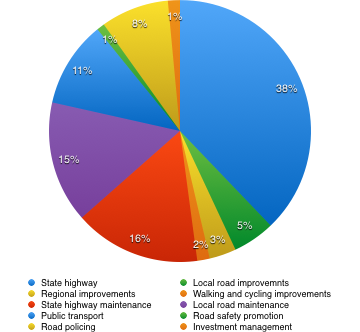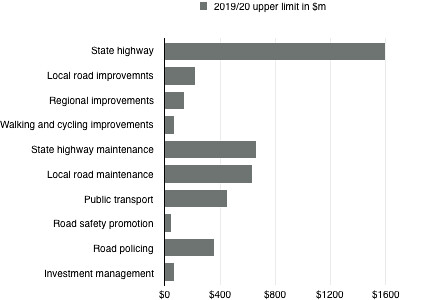
No it’s not to do with route finding but the Government Policy Statement on land transport 2018
The Statement, updated every 3 years, sets out Government’s policies for investment in land transport for the coming decade. The Ministry of Transport have recently issued a draft for consultation.
The document has so far received an unenthusiastic reception from transport experts and professionals with The NZ Institute of Engineers’ Transport Group making warning submissions prior to the draft and the respected Auckland Transport Blog crying, in a piece partly titled 'Roads, Roads, Roads', ‘We still see crazy boondoggle motorway projects being announced before a proper business case has been done. We still see the highly sensible proposal for a regional fuel tax being knocked back for no good reason. And, when it comes to the Government’s most important transport document – the Government Policy Statement (GPS) – we still see a very State Highways focused strategy for transport’.
To quote the Ministry, ‘The Government Policy Statement on land transport outlines the Government’s strategy to guide land transport investment over the next 10 years. It also provides guidance to decision-makers about where the Government will focus resources. The Land Transport Management Act 2003, sets out the scope, and requirements for the GPS.
‘The GPS influences decisions on how money from the National Land Transport Fund will be invested across activity classes, such as State highways and public transport. It also guides the NZ Transport Agency and local government on the type of activities that should be included in Regional Land Transport Plans and the National Land Transport Programme.
‘The GPS provides guidance on how over $3 billion of New Zealanders’ money is spent through the Fund each year. It also provides signals for spending of a further $1 billion each year on land transport through local government investment and another $1 billion a year of Crown investment is spent each year.
‘The revenue for the Fund is projected to increase from around $3.70 billion in 2018/19 to $4.25 billion in 2027/28 based on current level of fuel excise and road user charge rates. This funding is likely to be supplemented by about $1 billion a year of local government transport funding in the form of a local share.’
Seoul, San Francisco and Taipei are just three cities who have recently demolished major freeway overpasses, the international transport community having long realised that high dependence on private car use simply isn’t efficient or productive in an urban area and needs to be counteracted by developing other transport modes. But the new GPS allocates a whopping 38% to new State Highways — huge roading projects that generally encourage car dependence in surrounding districts and promote car-dependent sprawl, further marginalising bike use and drawing funds away from projects that might have helped. This GPS is globally positioning NZ in the wrong location.
It is true that cycling's share of the pie has pretty much doubled since the first draft of GPS 2015, and CAN have acknowledged that Minister Bridges has overseen continued investment in cycling. Indeed the NZTA's elevation of cycling to one of its 6 major priorities is arguably set to change the landscape for cyclists. And it has to be said that some of the roading projects will presumably have cycling provision built into their budgets. But cycling won't fulfil its potential to cater for most of NZ's short trips without being integrated into a sensible overall policy. My opinion is that there are significant issues with this Statement that should prevent CAN supporting the current draft—
- Lower limits for cycling & walking are worryingly low; less than a third of upper limits.
- Forecasts for transport use and freight are extrapolated from current use, with little ambition to, say, shift some of those long-distance heavy vehicle journeys to rail. Yes, the NZTA’s target 10 million extra annual cycling trips by 2019 is mentioned, but where’s the ambition to grow cycling to, say 10% of all commutes in major towns for instance?
- Making economic growth and productivity the top priority for the Statement is all very well, but with just on 80% of New Zealanders now living in urban areas, and about 40% of our trips being less than 5km, productivity is not best served by filling those urban areas with single-occupancy cars and parking, which is what the proposed level of investment in roading will encourage. Productivity of walking, cycling and public transport in urban areas can be shown to be much higher than short-trip car usage. The commentary in the Statement’s chapter 2 states this, but it’s not backed up on the bottom line and indeed it’s partly undermined when value-for-money scrutiny is proposed for public transport use.
- Likewise, the emphasis on value for money isn’t borne out by the allocation of such huge sums to projects with low benefit-cost ratios. There’s ample evidence that bike infrastructure offers very high benefit-cost ratios (which is why the UN recently called for 20% of all states’ transport budgets to be allocated to non-motorised transport modes) but this isn’t sufficiently acknowledged in the Statement. We won’t even get started about the external costs of NZ’s high level of car dependence beyond pointing out that there’s little mention of air pollution-induced asthma or inactivity-induced diabetes levels in this document.
The pie chart above is a simplification of GPS spending parameters. It shows the maximum spending for these activity classes set out for the 2019/20 year. Here's a bar chart giving the same figures in dollar form-
Investment in roads may not directly suppress cycling numbers -and some of the non-state highway roading budget will certainly be to improve cyclists’ journeys- but we already have a streetscape that is hostile to cyclists because, designed for the maximum throughput of cars, it leaves us so little space and makes intersections feel dangerous. Unthinking perpetuation of excessive car use goes against CAN’s goal of getting more people on bikes more often. Further, drawing limited investment from public transport -where cycling can be efficiently used to link up with bus and train trips- is a lost opportunity.
What do you think? The above is a personal opinion; CAN are working on a submission, to be made by March 31st, and would love to hear from cyclists. Check out the Ministry’s GPS page and CAN’s previous (2015) submission (pdf) and email will@can.org.nz with your thoughts.
-Will Andrews

